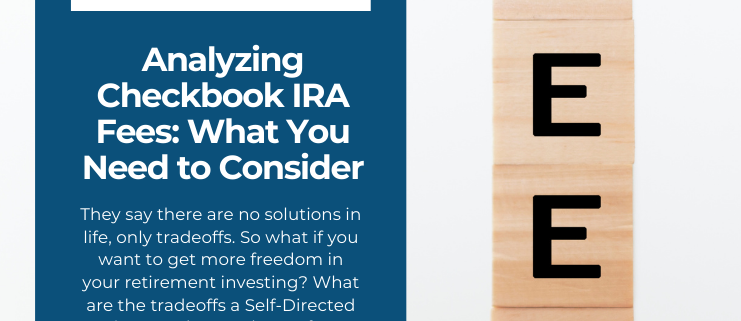Analyzing Checkbook IRA Fees: What You Need to Consider
They say there are no solutions in life, only tradeoffs. So what if you want to get more freedom in your retirement investing? What are the tradeoffs a Self-Directed IRA investor has to choose from? Well, you can pay high ongoing fees to have someone manage your account and cater to your every whim. Or you can take a more independent approach with a Checkbook IRA. Within your Checkbook IRA, you can manage the checkbook yourself. Since the checkbook belongs to the checking account of the business you keep within the IRA, the control reverts to you—and this can mean very low ongoing fees in the long run.
The trade off? You will need to pay some fees—like filing for the LLC for the company your IRA will own—upfront. But the results can be well worth this tradeoff, giving you more flexibility, more freedom, and more control. Here’s how.
Checkbook IRA Fees: What You Need to Know
What kinds of fees are you looking at if you set up a Checkbook IRA? Well, establishing a Checkbook IRA involves setting up a self-directed IRA and an accompanying LLC. The initial setup fee can vary significantly depending on the custodian and the complexity of the LLC structure.
In addition to the setup fee charged by the IRA custodian, you’ll also need to pay for the formation of the LLC. This typically includes state filing fees and legal fees if you hire an attorney to assist with the formation.
There are also some ongoing maintenance fees to consider. The IRA custodian usually charges an annual fee for maintaining the Checkbook IRA account. This fee covers services like account administration and compliance checks. However, one thing to consider here is that such fees are typically flat, meaning that they won’t expand as your account grows. That can be a major boon to anyone who puts aside a lot of money for retirement.
Anther fee to note: your LLC will incur ongoing costs. These can include state annual report fees and possible legal or accounting fees. Typically, LLC maintenance fees range from $100 to $500 per year, though in many states, these fees are not so expensive.
The Advantages of Checkbook IRA Fees
The good news? Checkbook IRA fees over the long-term don’t add up like they might in other accounts. Much of the fees involve first-time setup, and ongoing fees can be minimal since you’re doing so much of the account maintenance yourself. Of course, you’ll be free to hire people you want to work with, such as financial advisors, and they might charge you fees for their advice. But ultimately, the appeal of the Checkbook IRA is that the control lies in your hands.
Another thing to note? With a Checkbook IRA, you’re not restricted by the custodian’s limitations on investment types or transaction processes. You can invest in a wide range of assets. You get to choose. Want real estate or private equity? You can execute those transactions, swiftly, using the account’s checkbook. This flexibility can save time and reduce costs associated with processing delays or additional custodian fees.
And if that’s what you’re after, you may begin to realize that Checkbook IRA fees aren’t something to be feared. For many investors, they’re something to be embraced. Still, you should look into these fees before you start so that there aren’t any surprises along the way. To find out more about how it all works, feel free to reach out to us here at American IRA by dialing our number at 866-7500-IRA.



